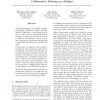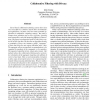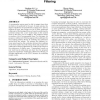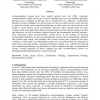JMLR
2010
13 years 10 months ago
2010
Matrix factorization is a successful technique for building collaborative filtering systems. While it works well on a large range of problems, it is also known for requiring signi...
DATAMINE
2010
14 years 28 days ago
2010
: In dyadic prediction, the input consists of a pair of items (a dyad), and the goal is to predict the value of an observation related to the dyad. Special cases of dyadic predicti...
WISE
2010
Springer
14 years 1 months ago
2010
Springer
Abstract. Association rule mining algorithms such as Apriori were originally developed to automatically detect patterns in sales transactions and were later on also successfully ap...
SP
2002
IEEE
14 years 3 months ago
2002
IEEE
Server-based collaborative filtering systems have been very successful in e-commerce and in direct recommendation applications. In future, they have many potential applications in...
SIGIR
2002
ACM
14 years 3 months ago
2002
ACM
Collaborative filtering (CF) is valuable in e-commerce, and for direct recommendations for music, movies, news etc. But today's systems have several disadvantages, including ...
SIGIR
2008
ACM
14 years 3 months ago
2008
ACM
Collaborative Filtering (CF) requires user-rated training examples for statistical inference about the preferences of new users. Active learning strategies identify the most infor...
SIGIR
2008
ACM
14 years 3 months ago
2008
ACM
A recommender system must be able to suggest items that are likely to be preferred by the user. In most systems, the degree of preference is represented by a rating score. Given a...
ECRA
2007
14 years 3 months ago
2007
Recommendation systems have been studied actively since the 1990s. Generally, recommendation systems choose one or more candidates from a set of candidates through a filtering pro...
IR
2006
14 years 3 months ago
2006
Collaborative filtering is a general technique for exploiting the preference patterns of a group of users to predict the utility of items for a particular user. Three different co...
DEBU
2008
14 years 3 months ago
2008
With the increasing popularity of recommender systems in commercial services, the quality of recommendations has increasingly become an important to study, much like the quality o...




